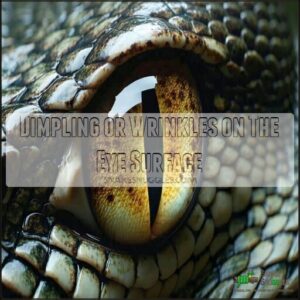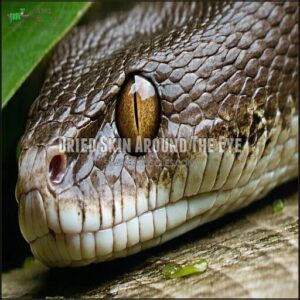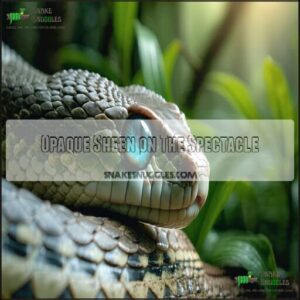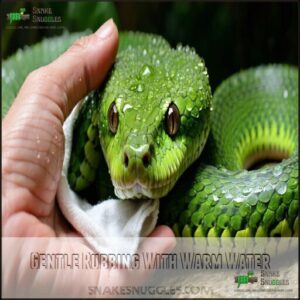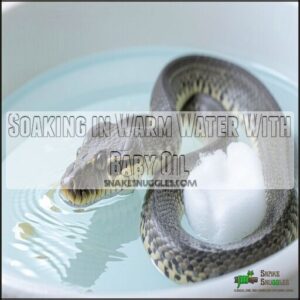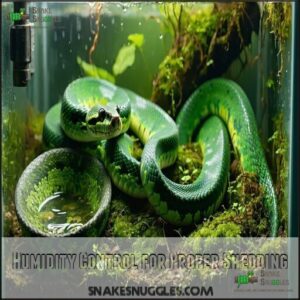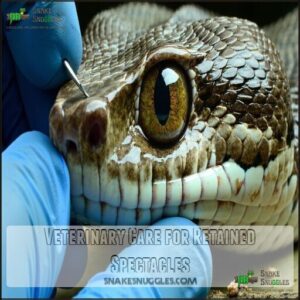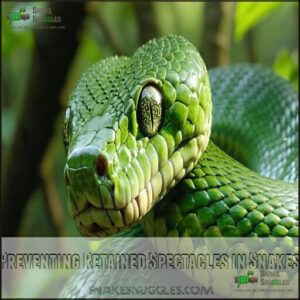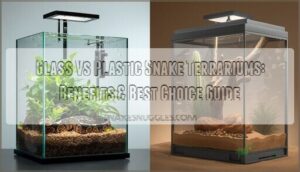This site is supported by our readers. We may earn a commission, at no cost to you, if you purchase through links.
 If your snake’s eye caps won’t come off, don’t panic—this is a common shedding issue called retained spectacles.
If your snake’s eye caps won’t come off, don’t panic—this is a common shedding issue called retained spectacles.
Start by increasing humidity in the enclosure, as a dry environment often causes this. Try soaking your snake in warm, shallow water for 15-20 minutes, then gently use a damp cotton swab to massage around the eyes.
Avoid using force—tugging can harm their delicate skin. In tricky cases, placing clear tape on the cap may help, but leave it to a vet if this doesn’t work.
Always monitor your snake’s health; unresolved caps can lead to infections. Proper environment care prevents this next time!
Table Of Contents
- Key Takeaways
- What Are Retained Spectacles?
- Identifying Retained Spectacles in Snakes
- Home Remedies for Removing Retained Spectacles
- Veterinary Care for Retained Spectacles
- Preventing Retained Spectacles in Snakes
- Frequently Asked Questions (FAQs)
- Why won’t my snakes’ eye caps come off?
- How do you remove a stuck snake skin?
- What does a stuck eye cap on a snake look like?
- How to tell if a ball python has a stuck eye cap?
- How to remove stuck eye caps from a snake?
- How to remove eye caps ball in Python?
- Why is my snakes shed not coming off?
- How do you remove retained spectacles?
- Can retained eye caps affect a snakes vision?
- How does a snake feel with retained caps?
- Conclusion
Key Takeaways
- Increase humidity in the snake’s enclosure and soak your snake in warm water to help loosen stuck eye caps.
- Use a damp cotton swab to gently massage around the eyes, but never apply force to avoid harming the snake.
- Persistent retained eye caps can cause infections or vision problems, so consult a reptile-savvy vet if home remedies don’t work.
- Prevent future issues by maintaining proper humidity levels, offering hydration, and providing rough surfaces in the enclosure.
What Are Retained Spectacles?
Retained spectacles, or stuck eye caps, happen when the transparent layer covering a snake’s eyes doesn’t shed properly.
This can cause discomfort and even lead to health issues if not addressed.
Causes of Retained Spectacles
Shedding problems, or dysecdysis, happens when your snake’s eye caps—those protective, see-through layers—don’t come off during a shed.
What causes these retained spectacles?
- Low Humidity: Without enough moisture, shedding becomes a struggle, leaving snake eye caps stuck in place.
- Mite Infestation: Tiny pests irritate the snake’s eyes, making shedding harder.
- Dehydration: A lack of proper hydration weakens skin, creating tough-to-remove retained spectacles.
- Smooth Enclosures: Without rough surfaces, your snake has no tools to help remove stuck skin.
Address these issues to prevent shedding problems.
Your snake will shed cleanly and remain free from the discomfort of retained spectacles.
Effects of Retained Spectacles on Snakes
When snake eye caps are retained, expect issues like stress, behavioral changes, and infection risk.
Retained spectacles can lead to eye damage, vision impairment, and even blindness.
Retained spectacles, if ignored, can cause lasting eye damage, impair vision, and even lead to blindness in snakes.
Your snake may act aggressive, erratic, or oddly withdrawn, and health problems, like delayed growth, feeding difficulties, or scarring, are common.
Ignoring retained eye caps could make things worse, impacting your snake’s comfort and overall well-being.
Differences Between Retained Spectacles and Normal Shedding
Distinguishing retained spectacles from a normal shedding cycle comes down to a few details:
- Complete Shed: In normal shedding, the skin peels off entirely, including the spectacle.
- Eye Appearance: Retained spectacles leave an opaque, cloudy look, while normal eyes clear post-shed.
- Skin Integrity: Retained skin around the eyes hints at stuck shed issues affecting snake behavior.
Snakes in their pre-shed phase may exhibit behavioral changes.
Identifying Retained Spectacles in Snakes
You’ll know your snake might’ve retained spectacles if their eyes look cloudy, wrinkled, or show dried skin around the edges.
Checking for these signs early helps you address the problem before it becomes serious.
Dimpling or Wrinkles on The Eye Surface
Noticing dimpling or wrinkles around your snake’s eye? That’s an early sign of retained eye caps, which can lead to stuck eye caps and vision impairment if ignored.
These deformities often stem from shedding frequency issues or dehydration.
Table of Causes and Solutions:
| Cause | Symptom | Risk Level | Solution |
|---|---|---|---|
| Dehydration Signs | Wrinkled eyes | High | Increase humidity, hydration |
| Mite Identification | Irritated scales | Medium | Treat mites promptly |
| Spectacle Deformity | Clouded scale | High | Seek vet help if severe |
| Improper Shedding | Stuck spectacles | Medium | Provide shedding aids |
Act early to keep your snake healthy!
Grey and Foggy Appearance of The Eye
When you notice a foggy appearance or cloudy eyes, it’s a red flag for retained eye caps.
These signs, often linked to low humidity, indicate spectacle opacity. Unchecked, they can cause vision impairment, dehydration signs, or infection risk.
One possible cause is environmental irritants.
Here’s what to watch for:
- Persistent cloudy eyes during the shedding cycle.
- An opaque sheen.
- Foggy appearance after shedding.
- Excessive scratching behavior.
- Changes in eye shape, which can be a sign of infection risk or vision impairment.
Dried Skin Around The Eye
If you notice dry skin gathering around your snake’s eyes, it’s not just a bad shedding cycle—it’s trouble brewing.
Watch for these signs:
- Crusty patches forming on or near the eyes
- Minor discharge hinting at skin hydration issues
- Peeling or scaling that suggests stuck eye caps
Left untreated, this can lead to infection risk, scale damage, or vision impairment.
Keep those eyes hydrated!
Opaque Sheen on The Spectacle
If your snake’s eye looks foggy with an opaque sheen, it’s likely dealing with retained eye caps. This sheen can affect vision, signaling stuck eye caps needing attention.
Spectacle opacity causes often include low humidity or shedding issues. Improve humidity or try soaking to loosen shed eye caps.
For persistent sheen changes, consult a vet to prevent snake eye problems or further complications with shedding, especially to address potential issues with shedding issues.
Home Remedies for Removing Retained Spectacles
When your snake struggles to shed its eye caps, a few simple home remedies can make a big difference.
From warm water soaks to humidity adjustments, these easy steps help keep your snake healthy and stress-free.
Gentle Rubbing With Warm Water
Warm water works wonders for stuck eye caps.
Warm water is your snake’s best friend when eye caps are stuck—it softens, soothes, and helps shed with ease.
Start with a pre-soak in warm water (around 85°F). Gently rub the snake’s eye with a damp cloth or Q-tip—think of it as a spa massage.
Use a light rubbing technique without pressing too hard. Frequency matters, so repeat as needed.
Snake eye soak products can also help. Afterward, make certain of proper post-rub care to avoid irritation, and remember that warm water is key.
Soaking in Warm Water With Baby Oil
If your snake has retained eye caps, soaking it in warm water with baby oil can work wonders. This combination softens the shed and hydrates the skin.
Here’s a simple method:
- Fill a shallow tub with warm water (85–90°F) and add a few drops of baby oil.
- Let your snake soak for 15–20 minutes.
- Gently rub the eye area with a moist cotton ball afterward.
This soothing process eases snake shedding problems safely. Regular cleaning helps prevent bacterial and parasitic issues.
Humidity Control for Proper Shedding
Humidity control can make shedding smoother for your snake. Keep humidity levels species-appropriate by misting daily and using a moisture-rich substrate.
A humidity box helps, especially for snakes struggling with lack of humidity. Guarantee proper enclosure design for balanced ventilation and consistent hydration.
| Humidity Monitoring | Shedding Aids |
|---|---|
| Mist daily | Add water bowls |
| Moist substrate | Use humidity box |
| Monitor enclosure | Boost moisture control |
Hydration guarantees shedding success! Many keepers purchase a pre-made shedding box for their snakes.
Veterinary Care for Retained Spectacles
If your snake’s eye caps are stuck and nothing you’ve tried is working, it’s time to call a vet.
They’ve got the tools and expertise to safely remove retained spectacles and address any underlying health issues, which can be a critical step in ensuring your snake’s health.
Importance of Seeking Veterinary Help
Professional expertise is essential when home remedies don’t cut it for snake eye cap removal.
Retained eye caps can cause infections or even permanent blindness if ignored. A reptile veterinarian has the tools and diagnostic accuracy to spot underlying snake health problems and safely address them.
They can provide surgical options or medication management if needed, ensuring your snake’s eye issues are fully resolved. By seeking veterinary care, you’re not just fixing the problem—you’re preventing blindness and protecting their long-term well-being.
When in doubt, always prioritize your snake’s health by consulting a trusted reptile expert.
Acetylcysteine Treatment for Retained Spectacles
When retained spectacles won’t budge, acetylcysteine treatment can work wonders.
This solution softens stubborn eye caps, easing removal while protecting your snake’s delicate tissues. Vets use it for safe, efficient results with minimal stress.
Here’s what makes acetylcysteine effective:
- Acetylcysteine Mechanism: Softens retained eye caps without harm.
- Dosage Guidelines: Carefully measured to suit your snake’s needs.
- Treatment Duration: Quick, usually completed in one session.
- Potential Side-Effects: Limited when handled by professionals.
- Alternative Medications: Rarely needed due to acetylcysteine’s reliability.
This treatment guarantees smooth snake eye cap removal and keeps your pet comfortable throughout the process.
Addressing Underlying Health Issues
When snake eye problems like retained spectacles arise, an underlying issue is often at play.
Dehydration, dietary deficiencies, or parasites can cause shedding struggles.
Parasite control is paramount since mites irritate the eyes and worsen stuck caps.
Malnutrition weakens overall health, so make certain your snake gets balanced meals.
Hydration’s importance can’t be overstated—low humidity or inadequate water dehydrates skin, making shedding harder.
If infection signs like redness appear, infection management through a vet is critical.
Sometimes, genetic predispositions or illness may also contribute.
Addressing these root causes guarantees healthy shedding cycles and keeps your snake’s vision crystal clear.
Maintaining proper enclosures helps prevent bacterial and fungal infections, which is crucial for infection management and overall snake health.
Preventing Retained Spectacles in Snakes
You can help your snake avoid stuck eye caps by keeping its enclosure humid and comfortable. A balanced diet and a clean, safe environment make shedding smoother and less stressful.
Maintaining Proper Humidity Levels
Getting your humidity levels just right is like finding the perfect balance in a recipe—it can save your snake from stuck eye caps.
Here’s how:
- Use reliable humidity monitors in various enclosure spots to maintain species-appropriate levels (50-70% for most snakes).
- Boost hydration by adjusting misting frequency and adding a humid hide.
- Account for species needs—tropical snakes may need 70-90%, while desert species prefer less.
Remember, lack of humidity often causes problems; proactive humidity control prevents retained eye caps easily.
Providing a Suitable Environment for Shedding
Creating the perfect shedding environment for your snake is like setting up a cozy spa day—it requires the right mix of space, warmth, and moisture. Start with a properly sized enclosure that matches your snake’s needs, guaranteeing enough room to move around.
Pay attention to humidity control by keeping species-appropriate humidity (50-70%) using a reliable hygrometer.
Here’s your checklist for success:
- Add rough surfaces like cork bark or branches for scraping during shedding.
- Provide a humid hide with moist sphagnum moss for extra moisture control.
- Maintain a temperature gradient of 75-85°F to support shedding.
- Guarantee daily access to fresh water for hydration.
A balanced setup guarantees smooth shedding and helps prevent retained eye caps. Consider purchasing a pre-made shedding box for convenience. Simple adjustments go a long way!
Monitoring Nutrition and Health for Snakes
Your snake’s overall health plays a big part in smooth shedding.
Keep an eye on their Dietary Needs with a balanced snake diet to avoid malnutrition.
Hydration Importance can’t be overstated—dehydration often leads to stuck eye caps.
Try Supplementation Strategies like calcium if necessary, and track weight regularly for insights.
Combine careful Health Monitoring with frequent Veterinary Checkups to spot issues early.
A well-fed, hydrated snake is far less likely to face shedding problems!
Frequently Asked Questions (FAQs)
Why won’t my snakes’ eye caps come off?
It’s like a stuck zipper—eye caps won’t come off due to low humidity, dehydration, or mites.
Increase enclosure humidity, soak your snake in warm water, and gently rub the eye area to help.
How do you remove a stuck snake skin?
To remove stuck snake skin, soak them in warm water for 15-20 minutes.
Then gently use a damp cloth or your fingers to encourage shedding.
A “shedding box” with increased humidity also helps.
What does a stuck eye cap on a snake look like?
A stuck eye cap looks like a cloudy, opaque layer covering the snake’s eye, often appearing wrinkled or dimpled.
You might notice dried skin around the eye or an incomplete shed missing eye holes.
How to tell if a ball python has a stuck eye cap?
Did you know improper humidity causes 90% of shedding issues?
If your ball python’s eye looks cloudy, wrinkled, or has a shiny, opaque spot after shedding, it’s likely dealing with a stuck eye cap.
How to remove stuck eye caps from a snake?
Gently soak your snake in warm water for 15-20 minutes.
Use a damp, soft cloth or cotton swab to carefully loosen the stuck cap.
If it won’t budge, consult a reptile-savvy vet promptly.
How to remove eye caps ball in Python?
Ever wonder why eye cap removal can be tricky?
For pythons, raise humidity and let them soak in warm water.
Use a damp Q-tip to gently nudge them off, or consult a vet.
Why is my snakes shed not coming off?
Your snake’s shed mightn’t come off due to low humidity, dehydration, or lack of rough surfaces in its enclosure.
Boost humidity, offer a warm soak, and make certain proper hydration to help.
How do you remove retained spectacles?
Start by soaking your snake in warm water for 15-20 minutes.
Use a damp cloth or Q-tip to carefully rub the eye area.
If it doesn’t come off, consult a reptile-savvy veterinarian.
Can retained eye caps affect a snakes vision?
Yes, retained eye caps can affect a snake’s vision by creating a cloudy, obstructed view.
If left unresolved, it might lead to infections or permanent eye damage, so addressing the issue promptly is essential.
How does a snake feel with retained caps?
Your snake likely feels uncomfortable and stressed with retained eye caps.
It might experience limited vision, irritation, or even pain.
You may notice it acting nervous, aggressive, or avoiding food due to the discomfort.
Conclusion
When your snake’s eye caps won’t come off, don’t sweat it—it’s more common than you think.
Boost enclosure humidity, try gentle soaking, and follow the tips above to help.
Always handle your snake with care, ensuring no harm comes to their delicate skin.
If home remedies don’t work, a vet visit is your best move to prevent infections.
With the right care, your snake will shed safely, and you’ll avoid future issues by maintaining a cozy, well-humidified habitat.


